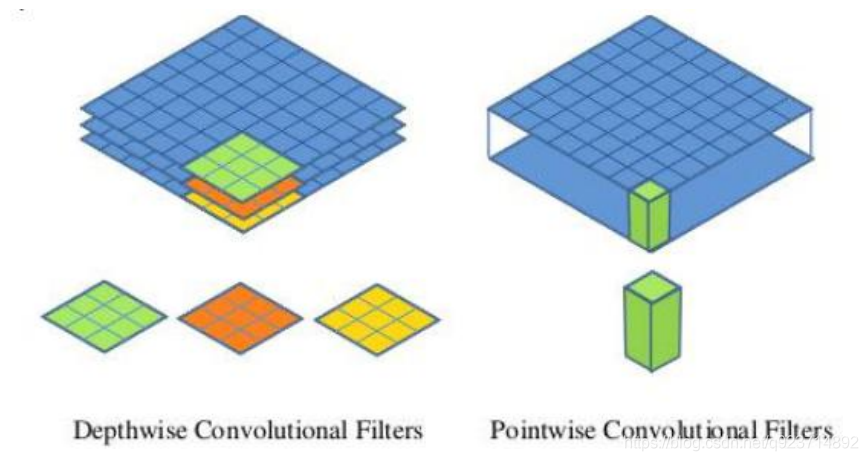Mobilenet概念:
MobileNet模型是Google针对手机等嵌入式设备提出的一种轻量级的深层神经网络,其使用的核心思想便是depthwise separable convolution。
Mobilenet思想:
通俗地理解就是3x3的卷积核厚度只有一层,然后在输入张量上一层一层地滑动,每一次卷积完生成 一个输出通道,当卷积完成后,在利用1x1的卷积调整厚度。

对于一个卷积点而言: 假设有一个3×3大小的卷积层,其输入通道为16、输出通道为32。具体为,32个3×3大小的卷积核会 遍历16个通道中的每个数据,最后可得到所需的32个输出通道,所需参数为16×32×3×3=4608个。
应用深度可分离卷积,用16个3×3大小的卷积核分别遍历16通道的数据,得到了16个特征图谱。在 融合操作之前,接着用32个1×1大小的卷积核遍历这16个特征图谱,所需参数为 16×3×3+16×32×1×1=656个。
可以看出来depthwise separable convolution可以减少模型的参数。

Mobilenet网络代码实现
网络主体部分:
#-------------------------------------------------------------#
# MobileNet的网络部分
#-------------------------------------------------------------#
import warnings
import numpy as npfrom keras.preprocessing import imagefrom keras.models import Model
from keras.layers import DepthwiseConv2D,Input,Activation,Dropout,Reshape,BatchNormalization,GlobalAveragePooling2D,GlobalMaxPooling2D,Conv2D
from keras.applications.imagenet_utils import decode_predictions
from keras import backend as Kdef MobileNet(input_shape=[224,224,3],depth_multiplier=1,dropout=1e-3,classes=1000):img_input = Input(shape=input_shape)# 224,224,3 -> 112,112,32x = _conv_block(img_input, 32, strides=(2, 2))# 112,112,32 -> 112,112,64x = _depthwise_conv_block(x, 64, depth_multiplier, block_id=1)# 112,112,64 -> 56,56,128x = _depthwise_conv_block(x, 128, depth_multiplier,strides=(2, 2), block_id=2)# 56,56,128 -> 56,56,128x = _depthwise_conv_block(x, 128, depth_multiplier, block_id=3)# 56,56,128 -> 28,28,256x = _depthwise_conv_block(x, 256, depth_multiplier,strides=(2, 2), block_id=4)# 28,28,256 -> 28,28,256x = _depthwise_conv_block(x, 256, depth_multiplier, block_id=5)# 28,28,256 -> 14,14,512x = _depthwise_conv_block(x, 512, depth_multiplier,strides=(2, 2), block_id=6)# 14,14,512 -> 14,14,512x = _depthwise_conv_block(x, 512, depth_multiplier, block_id=7)x = _depthwise_conv_block(x, 512, depth_multiplier, block_id=8)x = _depthwise_conv_block(x, 512, depth_multiplier, block_id=9)x = _depthwise_conv_block(x, 512, depth_multiplier, block_id=10)x = _depthwise_conv_block(x, 512, depth_multiplier, block_id=11)# 14,14,512 -> 7,7,1024x = _depthwise_conv_block(x, 1024, depth_multiplier,strides=(2, 2), block_id=12)x = _depthwise_conv_block(x, 1024, depth_multiplier, block_id=13)# 7,7,1024 -> 1,1,1024x = GlobalAveragePooling2D()(x)x = Reshape((1, 1, 1024), name='reshape_1')(x)x = Dropout(dropout, name='dropout')(x)x = Conv2D(classes, (1, 1),padding='same', name='conv_preds')(x)x = Activation('softmax', name='act_softmax')(x)x = Reshape((classes,), name='reshape_2')(x)inputs = img_inputmodel = Model(inputs, x, name='mobilenet_1_0_224_tf')model_name = 'mobilenet_1_0_224_tf.h5'model.load_weights(model_name)return modeldef _conv_block(inputs, filters, kernel=(3, 3), strides=(1, 1)):x = Conv2D(filters, kernel,padding='same',use_bias=False,strides=strides,name='conv1')(inputs)x = BatchNormalization(name='conv1_bn')(x)return Activation(relu6, name='conv1_relu')(x)def _depthwise_conv_block(inputs, pointwise_conv_filters,depth_multiplier=1, strides=(1, 1), block_id=1):x = DepthwiseConv2D((3, 3),padding='same',depth_multiplier=depth_multiplier,strides=strides,use_bias=False,name='conv_dw_%d' % block_id)(inputs)x = BatchNormalization(name='conv_dw_%d_bn' % block_id)(x)x = Activation(relu6, name='conv_dw_%d_relu' % block_id)(x)x = Conv2D(pointwise_conv_filters, (1, 1),padding='same',use_bias=False,strides=(1, 1),name='conv_pw_%d' % block_id)(x)x = BatchNormalization(name='conv_pw_%d_bn' % block_id)(x)return Activation(relu6, name='conv_pw_%d_relu' % block_id)(x)def relu6(x):return K.relu(x, max_value=6)def preprocess_input(x):x /= 255.x -= 0.5x *= 2.return xif __name__ == '__main__':model = MobileNet(input_shape=(224, 224, 3))img_path = 'elephant.jpg'img = image.load_img(img_path, target_size=(224, 224))x = image.img_to_array(img)x = np.expand_dims(x, axis=0)x = preprocess_input(x)print('Input image shape:', x.shape)preds = model.predict(x)print(np.argmax(preds))print('Predicted:', decode_predictions(preds,1)) # 只显示top1




有偏见)













